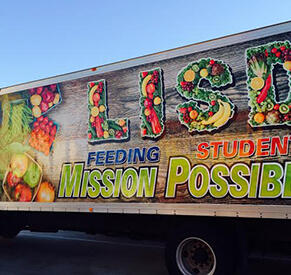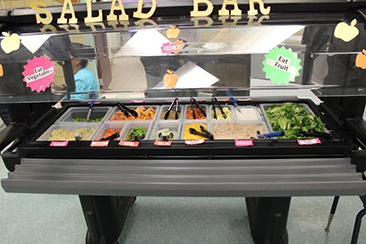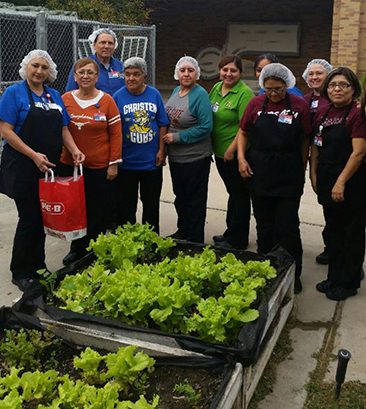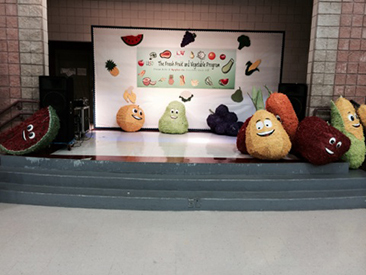
This blog was re-posted with the permission of Let’s Move Salad Bars to Schools. Read the original post here.
“The weather is changing a little bit down here… getting a bunch of rain but we’re still keeping our kids healthy, especially with our salad bars!” Robert Cuellar’s voice is cheerful and enthusiastic as he begins to describe his school’s vibrant salad bar program, the importance of educating and engaging students with healthy eating, and how his own children motivate him to continue to improve school food every day.
Robert is the Director of the Child Nutrition Program at Laredo Independent School District in Laredo, Texas. He is also the Chairman of the School Health Advisory Council for Laredo, involved in the Laredo Food Coalition, and an active advocate for anti-hunger efforts through the local food bank. Within the first five minutes of our discussion, it was evident that Robert’s passion for keeping Laredo’s children healthy and well-fed is a driving force in his life and work. Born and raised in Laredo, and a part of Laredo ISD for over 11 years, Robert has watched the district transform into the health-conscious and innovative institution that it is today. He reports to us that salad bars have been a huge part of this transformation.
Overcoming Skepticism
Times have changed in Laredo; students and staff have not always been motivated to bring healthy habits into the lunchroom. When the district first announced it would pursue a salad bar program in its 31 schools, it was met with extreme skepticism. The district, comprised of over 24,000 students, has a 98.2% free and reduced rate. Many students come from disadvantaged homes and backgrounds that don’t necessarily have the ability to support healthy at-home meals made with fresh fruits and veggies. Robert was told that the children would not eat the fruits and salads that were to be offered. Community critics anticipated the salad bars being a waste of money, and that the program would not live up to Robert’s expectations.
“If you do not showcase it, do not offer a nice presentation, students will not eat it.” Robert recognized this at the earliest stages of applying for the district’s eight salad bars through Let’s Move Salad Bars to Schools (LMSB2S), and set out to involve the most important critics of all - the students. Robert and his staff consulted the Student Menu Advisory Committee (SMAC), a group of 4 to 5 students from each school that provide suggestions and approval for the district’s menu cycles. To their surprise, there was overwhelming demand for salad bars from SMAC and their peers. Laredo students value the “food court” style cafeteria setup and were excited to be provided with even more choices to create healthier school meals.


“If you do not showcase it, do not offer a nice presentation, students will not eat it.” Robert recognized this at the earliest stages of applying for the district’s eight salad bars through Let’s Move Salad Bars to Schools (LMSB2S), and set out to involve the most important critics of all - the students. Robert and his staff consulted the Student Menu Advisory Committee (SMAC), a group of 4 to 5 students from each school that provide suggestions and approval for the district’s menu cycles. To their surprise, there was overwhelming demand for salad bars from SMAC and their peers. Laredo students value the “food court” style cafeteria setup and were excited to be provided with even more choices to create healthier school meals.
Techniques to Create A Successful Salad Bar
Robert took this enthusiasm to heart and was determined to show his students that the salad bars would be just as exciting as they’d hoped. After a few short months, the Whole Kids Foundation generously provided funding for eight salad bars for Laredo ISD’s upper schools. To engage students and keep their menus “fresh”, Robert and his staff set to work on the presentation of the bars. Colorful signage invited students to approach the salad bar, providing information on each item that was served, where it came from, and the vitamins and nutrients contained in each fresh fruit and vegetable. The district’s Menu Planner created rotating menu cycles with the approval of SMAC to feature seasonal produce from local Texas farms when available.
The salad bar was set up in each school at the end of the lunch line, allowing plenty of room for students to browse the available options and form a separate line from the hot lunch. One additional part-time staff person was hired in each school to help students with their selections, keep the area clean and stocked, and track the number of salads created during each lunch period. Robert reports that this additional staffing cost was offset because the cafeteria sold so many additional meals from the salad bar. Even the administration and teachers began to forego off-site meals to visit the beautiful salad display right in the lunchroom!

ood news travels fast, and as students began to build delicious and colorful plates, their friends and classmates eagerly followed suit. Robert told us that SMAC helped create their own marketing strategy, posting pictures of their lunch creations on social media and “tagging” their friends. Students showed excitement when they saw that each day the selections on the salad bar were a little different, allowing them to try new combinations each time. Favorites include lettuce, carrots, cucumber, cheese, chicken, tuna and chicken salad, strawberries, pineapple, and peaches. Robert also coordinated procurement from local farms, offering seasonal multi-colored carrots and cauliflower. Christen Middle School’s community garden helped grow lettuce for the salad bar in 2015, cutting food costs and allowing students to connect with where their meals came from.

ood news travels fast, and as students began to build delicious and colorful plates, their friends and classmates eagerly followed suit. Robert told us that SMAC helped create their own marketing strategy, posting pictures of their lunch creations on social media and “tagging” their friends. Students showed excitement when they saw that each day the selections on the salad bar were a little different, allowing them to try new combinations each time. Favorites include lettuce, carrots, cucumber, cheese, chicken, tuna and chicken salad, strawberries, pineapple, and peaches. Robert also coordinated procurement from local farms, offering seasonal multi-colored carrots and cauliflower. Christen Middle School’s community garden helped grow lettuce for the salad bar in 2015, cutting food costs and allowing students to connect with where their meals came from.
Unique Marketing Strategies Make All the Difference
Getting students excited within school walls is important, however Robert and his staff at Laredo ISD also use their community resources to expand their salad bar program from the inside out. Images of the program and its mission are painted on the vehicles that the district uses to transport produce from their local vendors. “When a truck drives by, people say ‘oh yes! That’s Laredo school food!’” Robert says. The district holds regular morning, evening, and weekend meetings between parents and school administration to discuss student breakfast options, menus, and school food topics. Parents are also invited to food expos where Robert and his staff showcase their salad bars and give taste tests of the district’s menu options.
In 2016, Laredo ISD applied for more LMSB2S funding to expand the salad bar program into its elementary schools. Marketing initiatives for the grade school salad bars have already begun to get students excited about new fruits and veggies coming their way. Robert and his wife have created a puppet show series called “Munchie’s Lunch Adventures” to help younger children gauge the importance of a balanced diet. To continue engaging younger students, Robert and his staff also plan to introduce the district’s new salad bar mascot and lunch superhero in March, to get students “super”-excited about healthy school food.


In 2016, Laredo ISD applied for more LMSB2S funding to expand the salad bar program into its elementary schools. Marketing initiatives for the grade school salad bars have already begun to get students excited about new fruits and veggies coming their way. Robert and his wife have created a puppet show series called “Munchie’s Lunch Adventures” to help younger children gauge the importance of a balanced diet. To continue engaging younger students, Robert and his staff also plan to introduce the district’s new salad bar mascot and lunch superhero in March, to get students “super”-excited about healthy school food.
Creating Healthy School Food
Robert and his staff make a difference in the lives of their students with every meal they serve. They are dedicated to keeping their students healthy and providing them with nutritious meals that they can be excited to eat. Laredo ISD and their food service program operate under five core values: Passion (to take care of every student’s meals and/or dietary needs), Hunger (to go that extra mile), Drive (to excel in their daily work), Dedication (to the Child Nutrition Program mission) and Service (to all children, staff and administration with dignity and respect).
The Child Nutrition Program’s website features games and activities that allow students to engage more with the healthy meals that they encounter in the lunchroom. Resources for parents such as menus, My Plate guidelines, and government resources provide even more education for students and their families to access at home.
Robert tells us, “I found my passions for health and wellness after noticing my parents had heart issues and diabetes from not eating healthy…I wanted to study something to benefit Texas and the city I was born in. I want to bring my wealth of knowledge back to my community.”
We’d say he’s off to a pretty great start!
Interested in reading more helpful articles from us? Sign-up for our newsletter in the footer below.







